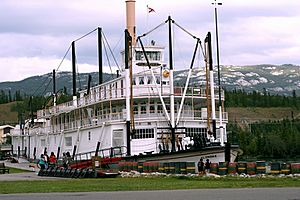SS Klondike facts for kids

Klondike II
|
|
| History | |
|---|---|
| Owner | British Yukon Navigation Co. |
| Launched |
|
| In service |
|
| Fate | Ran aground 1936 (Klondike I) |
| Status | Museum ship (Klondike II) |
| General characteristics Klondike II | |
| Type | Sternwheeler |
| Tonnage |
|
| Length | 64 m (210 ft) |
| Beam | 12.5 m (41 ft) |
| Draught |
|
| Depth | 1.5 m (4 ft 11 in) (molded depth) |
| Installed power | 2 × compound jet-condenser steam engines 525 hp (391 kW) |
| Propulsion | Stern paddlewheel |
| Capacity | 270 tonnes |
| Crew | 23 |
| Official name: SS Klondike National Historic Site of Canada | |
| Designated: | 24 June 1967 |
The SS Klondike was the name for two special sternwheelers. A sternwheeler is a type of boat that uses a large paddlewheel at the back to move through the water. The second Klondike is now a National Historic Site in Whitehorse, Yukon, Canada.
These ships were super important for moving goods. They carried freight between Whitehorse and Dawson City along the Yukon River. The first Klondike sailed from 1929 to 1936. The second, Klondike II, was almost exactly like the first. It operated from 1937 to 1950.
Contents
The First Klondike Ship
The first Klondike (Klondike I) was built in 1929. It was made by the British Yukon Navigation Company. This company was part of the White Pass and Yukon Route railway.
A Big Cargo Ship
Klondike I was special because it could carry a lot more cargo. It had 50% more space than other sternwheelers. Even with all that extra room, it could still travel easily. It had a shallow draft, which means the bottom of the boat didn't go very deep into the water. This was important for the Yukon River.
The ship could carry 270 metric tonnes of cargo. That's a huge amount! It could do this without needing to push another boat (a barge) alongside it.
An Unexpected Stop
In June 1936, Klondike I ran into trouble. It got stuck in the river north of a place called 'The Thirty Mile'. This is a specific section of the Yukon River.
The company worked to save parts of the ship. They took out the boiler, engines, and many other important pieces. These parts were then used to build Klondike II the very next year. If you go canoeing on the Yukon River when the water is low, you can still see the remains of Klondike I's hull!
The Second Klondike Ship
Klondike II took over from the first ship. It continued to carry freight until the early 1950s.
End of an Era
Things changed when a new highway was built. This road connected Dawson City and Whitehorse. Trucks could now carry goods much faster than the sternwheelers. Because of this, many sternwheelers on the Yukon River were stopped from operating.
To try and save Klondike II, it was changed into a cruise ship. The idea was for tourists to enjoy trips on the river. However, not enough people were interested. The cruise trips stopped in 1955. Klondike II was then left at the Whitehorse shipyards.
A Big Move
Later, the ship was given to Parks Canada. They slowly worked to fix it up. In 1966, the city decided to move the ship to its current spot. This was a huge job!
It took three bulldozers to push the ship. They also used eight tons of Palmolive soap to make it slide easier! A team of twelve men worked for three weeks to complete the move. They used greased log rollers to help the giant ship slide along.
A National Treasure
On June 24, 1967, the SS Klondike was named a National Historic Site of Canada. This means it's a very important part of Canada's history. Today, you can visit Klondike II during the summer. It's a popular place for tourists to learn about the past.

